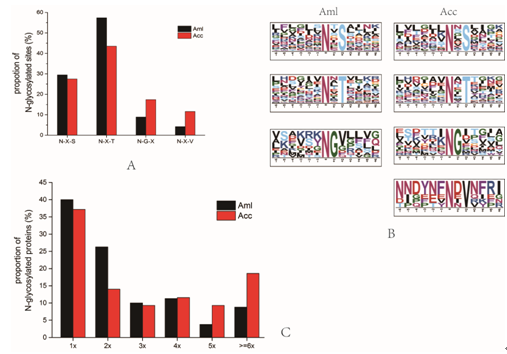J.Proteome Res:农科院李建科研究组发表蜂王浆糖蛋白质组与生物学
近日,蛋白质组学研究重要期刊《Journal of Proteome Research》上发表中国农业科学院蜜蜂研究所李建科教授研究组发表的蜂王浆糖蛋白质组与生物学功相关研究结果,第一作者为蜜蜂所冯毛,通讯作者为蜜蜂所李建科教授。
蛋白质的糖基化修饰对蛋白质生物学功能具有重要影响。尽管蜂王浆蛋白是糖蛋白,但糖基化修饰的特点以及糖基化修饰与蜂王浆蛋白功能的关系仍不十分清楚。该团队利用糖蛋白质组和功能研究等手段,对中蜂和意蜂蜂王浆的糖基化进行了系统分析。从意蜂蜂王浆中鉴定得到80个N-链接糖蛋白,发现190修饰位点,同时首次在中蜂蜂王浆中鉴定得到43个N-链接糖蛋白,发现138个修饰位点。由于长期的进化过程差异,导致了中意蜂蜂王浆形成了种属差异性的糖蛋白质组特征,这些差异同时也反映在蛋白的功能上。经N-糖基化修饰的王浆主蛋白1(MRJP1)都具有抗高血压的功效,但中蜂蜂王浆抗高血压效果优于意蜂浆;经N-糖基化修饰的王浆主蛋白2(MRJP2)都能够有效抑制幼虫芽孢杆菌(美洲幼虫腐臭病的致病菌,能够引起烂子病,是蜜蜂幼虫的一种严重的传染病),但中蜂蜂王浆的抑制能力显著高于意蜂,因此中蜂不易患美洲幼虫腐臭病。本研究不仅系统揭示了中意蜂蜂王浆糖基化修饰的特征,同时深入研究了蜂王浆蛋白必须经糖基化修饰才具有调节血压和抑菌等生物学功能,为蜂王浆功能成分的深入研究和利用奠定了基础。

原文链接:
In-Depth N-Glycosylation Reveals Species-Specific Modifications and functions of the Royal Jelly Protein from Western (Apis mellifera) and Eastern Honeybees (Apis cerana)
原文摘要:
Royal jelly (RJ), secreted by honeybee workers, plays diverse roles as nutrients and defense agents for honeybee biology and human health. Despite being reported to be glycoproteins, the glycosylation characterization and functionality of RJ proteins in different honeybee species are largely unknown. An in-depth N-glycoproteome analysis and functional assay of RJ produced by Apis mellifera lingustica (Aml) and Apis cerana cerana (Acc) were conducted. RJ produced by Aml yielded 80 nonredundant N-glycoproteins carrying 190 glycosites, of which 23 novel proteins harboring 35 glycosites were identified. For Acc, all 43 proteins glycosylated at 138 glycosites were reported for the first time. Proteins with distinct N-glycoproteomic characteristics in terms of glycoprotein species, number of N-glycosylated sites, glycosylation motif, abundance level of glycoproteins, and N-glycosites were observed in this two RJ samples. The fact that the low inhibitory efficiency of N-glycosylated major royal jelly protein 2 (MRJP2) against Paenibacillus larvae (P. larvae) and the absence of antibacterial related glycosylated apidaecin, hymenoptaecin, and peritrophic matrix in the Aml RJ compared to Acc reveal the mechanism for why the Aml larvae are susceptible to P. larvae, the causative agent of a fatal brood disease (American foulbrood, AFB). The observed antihypertension activity of N-glycosylated MRJP1 in two RJ samples and a stronger activity found in Acc than in Aml reveal that specific RJ protein and modification are potentially useful for the treatment of hypertensive disease for humans. Our data gain novel understanding that the western and eastern bees have evolved species-specific strategies of glycosylation to fine-tune protein activity for optimizing molecular function as nutrients and immune agents for the good of honeybee and influence on the health promoting activity for human as well. This serves as a valuable resource for the targeted probing of the biological functions of RJ proteins for honeybee and medical communities.
DOI: 10.1021/acs.jproteome.5b00829
作者:李建科

